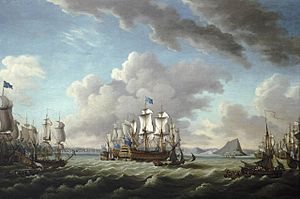Battle of Cape Spartel facts for kids
Quick facts for kids Battle of Cape Spartel |
|||||||
|---|---|---|---|---|---|---|---|
| Part of the American Revolutionary War | |||||||
 Relief of Gibraltar by Earl Howe, 11 October 1782, Richard Paton |
|||||||
|
|||||||
| Belligerents | |||||||
| Commanders and leaders | |||||||
| Strength | |||||||
| 34 ships of the line 1 frigate |
34 ships of the line | ||||||
| Casualties and losses | |||||||
| 276 killed and wounded | 360 killed and wounded | ||||||
The Battle of Cape Spartel was a naval battle that didn't have a clear winner. It happened on October 20, 1782. The battle was between a combined fleet from France and Spain, led by Admiral Luis de Córdova y Córdova, and a British fleet, led by Admiral Richard Howe. This fight took place after Admiral Howe successfully delivered supplies to Gibraltar. At the time, Gibraltar was under a long siege by French and Spanish forces during the American Revolutionary War.
Contents
Why the Battle Happened
When Spain joined the American War of Independence in 1779, one of its main goals was to capture Gibraltar. Gibraltar was a very important territory held by Great Britain. Soon after Spain declared war, French and Spanish forces started a huge siege of Gibraltar. They blocked land access and tried to stop ships from reaching it.
Britain had managed to resupply Gibraltar in 1780 and 1781. They knew they needed to do it again in 1782. This was a very important mission for British leaders. Spain was trying to get Gibraltar back in peace talks.
Admiral Richard Howe was in charge of the British Channel Fleet. His fleet had many jobs in the summer of 1782. They had to protect the English Channel from French and Spanish ships. They also had to guard against possible attacks from the Dutch in the North Sea. Most importantly, they had to protect the ships carrying supplies to Gibraltar.
A large group of supply ships, called a convoy, sailed on September 11. It included 35 warships and many transport ships for Gibraltar. Bad weather and strong winds delayed the fleet. They didn't reach Cape St. Vincent until October 9.
The French and Spanish fleet was blocking Gibraltar. It had 49 warships and was led by Spanish Admiral Luis de Córdova. Many of the Spanish ships were not in good condition. On October 10, a big storm hit the allied fleet. One ship ran aground, another was pushed under Gibraltar's cannons, and a third was swept into the Mediterranean Sea.
Admiral Howe gave his captains detailed instructions to make sure the supply ships arrived safely. On October 11, the supply ships began entering the Straits of Gibraltar. The British warships followed to protect them. Four supply ships made it to Gibraltar, but strong currents carried the rest into the Mediterranean. The British fleet followed them.
The French and Spanish fleet chased the British. On October 15, the British fleet, with a good wind, re-entered the straits. They successfully brought all the supply ships into Gibraltar between October 16 and 18.
The Battle Itself
On October 19, the allied French and Spanish fleet was seen east of Gibraltar. Admiral Howe wanted to avoid fighting inside the narrow straits. So, he sailed his fleet west, and the allied ships followed. Once they were out of the straits, Howe slowed his fleet down. This gave Admiral de Córdova the chance to start a battle.
On October 20, de Córdova ordered a "general chase," meaning his ships should pursue the British. The British ships were lined up to the right of the French and Spanish ships. Around 1:00 PM, the two fleets were about two miles apart. The British slowed down to keep their battle line tight.
At 5:45 PM, the front of the French and Spanish fleet started firing. The British fired back. Howe then ordered his ships to "retreat all sail." This move made at least 14 French and Spanish ships unable to join the fight. No British ships were seriously damaged. De Córdova's ships chased the British fleet, but couldn't catch them.
On October 21, the two fleets were about 12 miles apart. De Córdova made repairs and was ready to fight again. However, no battle happened the next day. Howe had already sailed back to Britain, following his orders.
What Happened After
Admiral Howe achieved his main goal: the supply ships arrived safely at Gibraltar. He then returned to England. This successful resupply helped the British soldiers at Gibraltar survive. It was a very important victory for Britain, especially since they had been losing battles in other places like Minorca and Florida.
The timely supplies and the failed French and Spanish attack on Gibraltar in September greatly helped Britain in peace talks. British diplomats firmly refused to give up Gibraltar. This was true even though Spain offered to trade many of its other gains.
The British ships were faster, partly because they used a special coating called copper sheathing on their hulls. This made it harder for other navies, like the Spanish, to catch them. The Spanish Navy was slower to start using this technology. Some of their older, heavier ships, like the Santisima Trinidad, were also very slow.
Ships in the Battle
The British fleet, led by Admiral Howe, had 34 warships and 1 frigate. The combined French and Spanish fleet, led by Admiral de Córdova, had 34 warships that took part in the main action. Some other ships were unable to join the fight.
The British had 276 sailors killed or wounded. The French and Spanish had 360 killed or wounded.
Images for kids
See also
 In Spanish: Batalla del Cabo Espartel (1782) para niños
In Spanish: Batalla del Cabo Espartel (1782) para niños


